Rank Species | ||
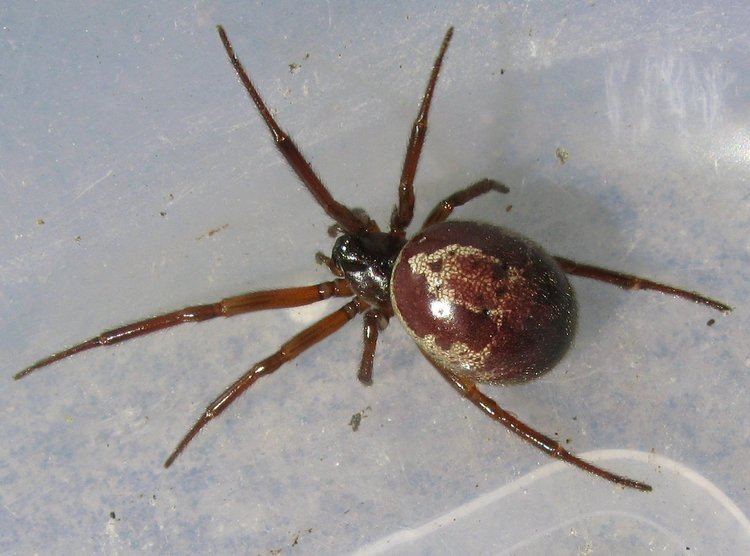 | ||
Similar False black widows, Steatoda grossa, Widow spiders, Theridiidae, Southern black widow | ||
Steatoda nobilis false widow spider
Steatoda nobilis is a spider in the genus Steatoda, known in the United Kingdom as the noble false widow and often referred to as the false widow. As the common name indicates, the spider superficially resembles and is frequently confused for the black widow and other spiders in the genus Latrodectus, which can have medically significant venom. Steatoda nobilis is native to Madeira and the Canary Islands from where it allegedly spread to Europe, and arrived in England before 1879, perhaps through cargo sent to Torquay. In England it has a reputation as one of the few local spider species which is capable of inflicting a painful bite to humans, with most bites resulting in symptoms similar to a bee or wasp sting.
Contents
- Steatoda nobilis false widow spider
- False widow spider handling steatoda nobilis
- Description
- Distribution habitat and ecology
- Population expansion in UK and Ireland
- Medical significance
- Media reaction
- Alleged incidents
- References

False widow spider handling steatoda nobilis
Description

Steatoda nobilis has a brown bulbous abdomen with cream coloured markings that are often likened to the shape of a skull. The legs are reddish-orange. Females range in size from about 9.5 to 14 mm in size, while males are 7 to 11 mm. Males are able to produce stridulation sounds during courtship, by scraping 10-12 teeth on the abdomen against a file on the rear of the carapace.
Distribution, habitat and ecology
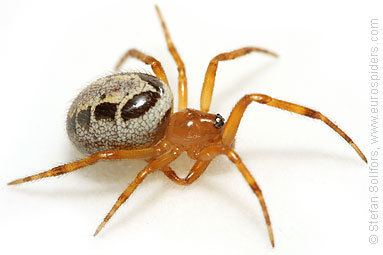
The spider is an introduced species across Europe, plus parts of North Africa, and likely spreading. It was found for the first time in 2011 in Cologne, Germany. It is originally from the Canary Islands and Madeira. In England it has been reported mostly in southern counties, but its range appears to be expanding northwards. In 2011, the spider was reported as an established invasive species in the USA, in Ventura County, California. In January 2016, it was reported that Steatoda nobilis had been found in Chile, the first time that the species had been recorded in the southern hemisphere.
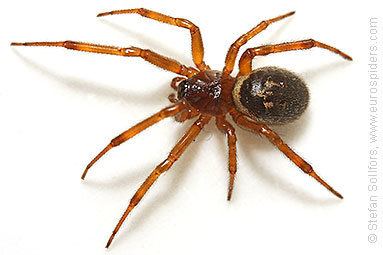
As with other members of the family Theridiidae, Steatoda nobilis constructs a cobweb which is an irregular tangle of sticky silken fibres. Its 'scaffold web' differs from others of the genus in the exceptional strength of the silk, and in the tubular retreat that is at least partly concealed in a deep crack or hole. They have poor eyesight and depend mostly on vibrations reaching them through their webs to orient themselves to prey or warn them of larger animals that could injure or kill them.
Population expansion in UK and Ireland
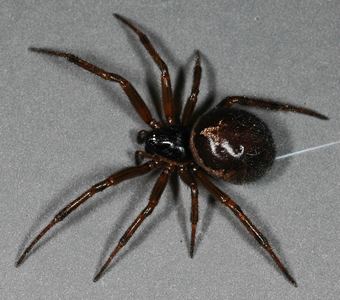
The distribution of Steatoda nobilis is expected to increase northwards in the UK, due to, at least partly, mild winters in recent years. This prediction was reported by Stuart Hine of the Natural History Museum, and is substantiated by the National Recording Scheme.
The spider is reported to be an established species in Ireland.
Medical significance
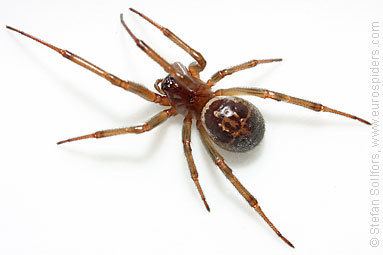
Like almost all spiders, Steatoda nobilis is venomous, but its bite is almost exclusively of mild effect on humans, without the severe consequences that can occur with black widow spiders. Its bite is often alleged to be one of the medically significant for humans, even though the few recorded bites do not typically present long-lasting effects. The symptoms of a bite are typically similar to a bee or wasp sting. The bite of this spider, along with others in the genus Steatoda, can produce a set of symptoms known as steatodism. Symptoms of bites include intense pain radiating from the bite site, along with feverishness or general malaise. Male bites are less severe than that of the female.
Media reaction
Sensationalised stories about the bite of Steatoda nobilis have featured in UK newspaper articles. Stuart Hine from the Natural History Museum, London responded on the naturenet blog, stating, "Of course I also explain the great value of spiders and how rare the event of spider bite in the UK actually is. I also always explain that up to 12 people die from wasp/bee stings in the UK each year and we do not panic so much about wasps and bees – but this never makes it past editing." Steven Falk, an entomologist, cautioned that without "hard evidence", it is difficult to know how many of the bites reported in the media have been caused by false widow spiders. The arrival of Steatoda nobilis in Chile in 2016 led to a similar media reaction.
